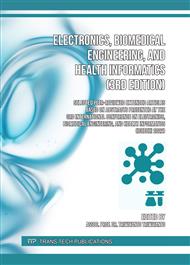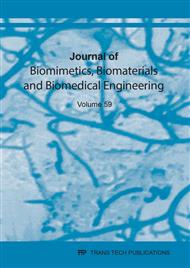[1]
A. Ranga et al., Neural tube morphogenesis in synthetic 3D microenvironments,, Proc. Natl. Acad. Sci. U. S. A., vol. 113, no. 44, pp. E6831–E6839, (2016).
DOI: 10.1073/pnas.1703993114
Google Scholar
[2]
A. Ranga, N. Gjorevski, and M. P. Lutolf, Drug discovery through stem cell-based organoid models,, Adv. Drug Deliv. Rev., vol. 69–70, p.19–28, (2014).
DOI: 10.1016/j.addr.2014.02.006
Google Scholar
[3]
S. Montes-Olivas, L. Marucci, and M. Homer, Mathematical Models of Organoid Cultures,, Front. Genet., vol. 10, no. September, p.1–10, (2019).
DOI: 10.3389/fgene.2019.00873
Google Scholar
[4]
A. R. Abdel Fattah, S. Grebeniuk, L. P. de Rooij, I. Salmon, S. Poovathingal, and A. Ranga, Neuroepithelial Organoid Patterning is Mediated by Wnt-Driven Turing Mechanism,, SSRN Electron. J., (2021).
DOI: 10.2139/ssrn.3811873
Google Scholar
[5]
C. J. Demers et al., Development-on-chip: In vitro neural tube patterning with a microfluidic device,, Dev., vol. 143, no. 11, p.1884–1892, (2016).
DOI: 10.1242/dev.126847
Google Scholar
[6]
P. Rifes et al., Modeling neural tube development by differentiation of human embryonic stem cells in a microfluidic WNT gradient,, Nat. Biotechnol., vol. 38, no. 11, p.1265–1273, (2020).
DOI: 10.1038/s41587-020-0525-0
Google Scholar
[7]
S. Grebenyuk et al., Engineering large-scale perfused tissues via synthetic 3D soft microfluidics,, bioRxiv, p.2021.08.20.457148, (2021).
DOI: 10.1101/2021.08.20.457148
Google Scholar
[8]
I. Salmon et al., Engineering neurovascular organoids with 3D printed microfluidic chips,, Lab Chip, vol. 22, no. 8, p.1615–1629, (2022).
DOI: 10.1039/d1lc00535a
Google Scholar
[9]
K. Ishihara, A. Ranga, M. P. Lutolf, E. M. Tanaka, and A. Meinhardt, Reconstitution of a patterned neural tube from single mouse embryonic stem cells,, Methods Mol. Biol., vol. 1597, no. March, p.43–55, (2017).
DOI: 10.1007/978-1-4939-6949-4_4
Google Scholar
[10]
A. R. Abdel Fattah et al., Actuation enhances patterning in human neural tube organoids,, Nat. Commun., vol. 12, no. 1, p.1–13, (2021).
Google Scholar
[11]
G. I. Bell and E. C. Anderson, Cell Growth and Division: I. A Mathematical Model with Applications to Cell Volume Distributions in Mammalian Suspension Cultures,, Biophys. J., vol. 7, no. 4, p.329–351, (1967).
Google Scholar
[12]
S. Gowal, M. De Giacomi, and J. Y. Le Boudec, Comment on: A validated mathematical model of cell-mediated immune response to tumor growth [1],, Cancer Res., vol. 67, no. 17, p.8419–8420, (2007).
DOI: 10.1158/0008-5472.can-07-0238
Google Scholar
[13]
A. M. Jarrett et al., Mathematical models of tumor cell proliferation: A review of the literature, vol. 18, no. 12. (2018).
Google Scholar
[14]
S. Yoon, L. Id, B. L. Id, and B. Mallick, Estimation of COVID-19 spread curves integrating global data and borrowing information,, p.1–17, (2020).
DOI: 10.1101/2020.04.23.20077065
Google Scholar
[15]
E. Karzbrun, A. H. Khankhel, and S. J. Sterichan, Recapitulating neural tube morphogenesis with human pluripotent stem cells,, p.1–14, (2021).
DOI: 10.21203/rs.3.pex-1606/v1
Google Scholar
[16]
Y. Wu, S. Peng, R. H. Finnell, and Y. Zheng, Organoids as a new model system to study neural tube defects,, FASEB J., vol. 35, no. 4, p.1–11, (2021).
DOI: 10.1096/fj.202002348r
Google Scholar
[17]
A. R. G. Libby et al., Axial elongation of caudalized human organoids mimics aspects of neural tube development,, Dev., vol. 148, no. 12, p.1–32, (2021).
DOI: 10.1242/dev.198275
Google Scholar
[18]
A. Meinhardt et al., 3D reconstitution of the patterned neural tube from embryonic stem cells,, Stem Cell Reports, vol. 3, no. 6, p.987–999, (2014).
DOI: 10.1016/j.stemcr.2014.09.020
Google Scholar
[19]
E. Choi, S. Yoon, Y. E. Koh, Y. Seo, and K. P. Kim, Maintenance of genome integrity and active homologous recombination in embryonic stem cells,, Exp. Mol. Med., p.1220–1229, (2020).
DOI: 10.1038/s12276-020-0481-2
Google Scholar
[20]
A. R. Abdel Fattah and A. Ranga, Nanoparticles as Versatile Tools for Mechanotransduction in Tissues and Organoids,, Front. Bioeng. Biotechnol., vol. 8, no. April, p.1–12, (2020).
DOI: 10.3389/fbioe.2020.00240
Google Scholar
[21]
I. Nurisusilawati and M. Yusro, Prosthesis Mapping and Forecasting as a Direction of Innovation in Prosthesis Product Development Number of Prosthesis Use in the Last 3 Years,, vol. 14, no. 1, p.30–37, (2021).
DOI: 10.31315/opsi.v14i1.4579
Google Scholar
[22]
F. Goormaghtigh and L. Van Melderen, Single-cell imaging and characterization of Escherichia coli persister cells to ofloxacin in exponential cultures,, p.1–15, (2019).
DOI: 10.1126/sciadv.aav9462
Google Scholar
[23]
S. Kim and H. Kim, A new metric of absolute percentage error for intermittent demand forecasts,, Int. J. Forecast., vol. 32, no. 3, p.669–679, (2016).
DOI: 10.1016/j.ijforecast.2015.12.003
Google Scholar
[24]
J. Mckenzie, Mean absolute percentage error and bias in economic forecasting,, Econ. Lett., vol. 113, no. 3, p.259–262, (2011).
DOI: 10.1016/j.econlet.2011.08.010
Google Scholar
[25]
M. V. Makridakis S, Wheelwright SC, Forecasting: Methods and Applications, 2nd ed, Second Edi. John WIley and Sons, (1983).
Google Scholar
[26]
T. Informatics, S. Republic, and S. Republic, Forecasting using simple exponential smoothing method ´ ∗ ,, vol. 12, no. 3, p.62–66, (2012).
Google Scholar
[27]
P. A. Netti, Solid stress inhibits the growth of multicellular tumor spheroids,, Nat. Biotechnol., vol. 15, p.778–763, (1997).
DOI: 10.1038/nbt0897-778
Google Scholar
[28]
M. Klein, Two Alternatives to the Shewhart X Control Chart,, vol. 32, no. 4, p.427–431, (2000).
Google Scholar
[29]
Y. M. Wo and Z. Ahmad, Validation oF Ra-226 and K-40 Measurment in Environmental Sample using Gamma Spectroscopy System,, Malaysian J. Anal. Sci., vol. 12, no. 1, p.179–186, (2008).
Google Scholar
[30]
H. T. Nia, M. Datta1, G. Seano, P. Huang, L. L. Munn1, and R. K. Jain, Quantifying solid stress and elastic energy from excised or in situ tumors,, Nat. Protoc., vol. 13, no. 5, (2018).
DOI: 10.1038/nprot.2018.020
Google Scholar
[31]
H. T. Nia et al., Solid stress and elastic energy as measures of tumour mechanopathology Hadi,, Nat. Biomed. Eng., no. 1, (2016).
Google Scholar



